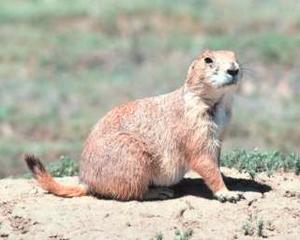Plague Poses Widespread Risk to North American Wildlife
FORT COLLINS, Colorado, March 1, 2010 (ENS) – Sylvatic plague – a close cousin of the dreaded disease that killed one-third of all European residents in the six years between 1347 and 1353 – persists in rodents in the American West even when the disease does not erupt into epidemic form, new research demonstrates.
The newly published work indicates that plague continues to affect the black-footed ferret, one of the most critically endangered mammals in North America, as well as several species of prairie dogs, including the federally threatened Utah prairie dog.
The disease also has been found in larger predators such as cougars and lynx that prey on rodents, rabbits, chipmunks and squirrels that may be susceptible to plague.
Plague, a flea-borne disease caused by the bacterium Yersinia pestis was introduced to North America in the late 1800s. It spreads rapidly, causing devastating effects to wildlife and posing risks to people.
 |
Dean Biggins (Photo courtesy USGS) |
“The overall difficulty of detecting plague in the absence of a large-scale die-off serves as a warning for those dedicated to wildlife conservation and human health,” said Dean Biggins, a wildlife biologist with the U.S. Geological Survey based in Fort Collins. Biggins is co-author of two papers published Wednesday in a special issue of the journal “Vector-Borne and Zoonotic Diseases,” that focuses on the plague.
“Hazards from plague may exist even where there have never been epidemics that caused widespread and readily detectable levels of mortality among local rodents such as prairie dogs,” Biggins warns.
As an example, Biggins points to the death two years ago of a National Park Service employee in Arizona. The man died of plague contracted from an infected cougar that he had found dead, even though a plague epidemic had not been observed in the area’s resident prairie dog populations.
Currently plague can be found circulating in rodent populations on five continents – all except Australia and Antarctica – where ground-dwelling rodents live in semi-arid climates.
Although Y. pestis appears to be transmitted primarily among certain rodents and their fleas, more than 200 species of mammals have been reported to be naturally infected.
Conservation and recovery efforts for imperiled species such as the black-footed ferret and Utah prairie dog are hampered by the effects of plague. Eruptions of the fatal disease have wiped out prairie dog colonies, as well as dependent ferret populations, in many locations over the years.
“The impacts of plague on mammal populations remain unknown for all but a few species, but the impact on those species we have studied raises alarms as well as important questions about how plague might be affecting conservation efforts in general,” said Biggins.
 |
Black-tailed prairie dog (Photo by Dean Biggins courtesy USGS) |
As a predator of prairie dogs, black-footed ferrets have been driven to the brink of extinction by loss of prairie dogs during widespread plague events called epizootics. Black-footed ferrets, too, are susceptible to this pathogen.
But research by Biggins and his colleagues indicates that plague may be maintained in the wild within colonies of prairie dogs even without causing the large-scale, rapid die-off of prairie dogs.
The mechanisms of the bacterium’s low-level presence and survival in the absence of a large-scale die-off of prairie dogs, remain under investigation.
In view of these facts, Biggins says researchers need to reassess the possible role of plague in population declines of many species of conservation concern in the western United States such as the pygmy rabbit, the northern Idaho ground squirrel, the riparian brush rabbit.
Many squirrel species in the western United States may also be infected with plague, says Biggins, particularly those animals “occupying fragmented habitats within plague-endemic regions” such as the Uinta chipmunk, Tamias umbrinus nevadensis, and the golden-mantled ground squirrel, Spermophilus lateralis wortmanni.
Biggins says even carnivore species such as Canada lynx are likely to have been affected by the plague. He cites unpublished data held by the Centers for Disease Control and Prevention documenting “numerous samples collected from dead lynx at reintroduction sites in Colorado and later submitted for analysis to the CDC.”
Biologists hope that a new plague vaccine may prove effective in controlling the disease. Added to prairie dog food it shows significant promise in the laboratory, USGS researchers have found.
The papers in the special issue of Vector-Borne and Zoonotic Diseases, Vol. 10 No. 1 are part of a collection presented at an international symposium on the ecology of plague and its effects on wildlife, held in Fort Collins, Colorado, in November 2008. The symposium was co-sponsored by the U.S. Geological Survey, the U.S. Fish and Wildlife Service, Colorado State University, and the U.S. Centers for Disease Control and Prevention.
Papers in the special issue cover how plague persists in the wild, the role of rodents and other host species in disease transmission, diagnostic techniques, factors that affect the occurrence and spread of plague, effects to wildlife populations, and disease management and control. For a limited time, the journal will be available online at no charge.
Copyright Environment News Service (ENS) 2010. All rights reserved.
